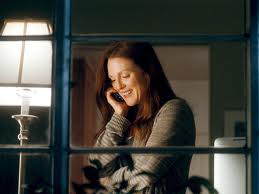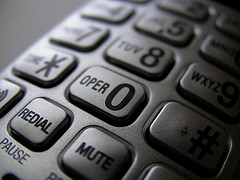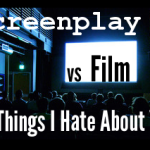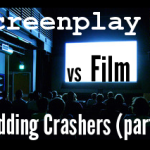“Get rid of phone call scenes,” has become a bit of a refrain on Scribe Meets World. It crops up again and again in articles from the Screenplay vs Film series. Even phone call scenes written with the greatest of care usually get the axe by the time a movie is actually produced. They’re replaced with something much better: face-to-face interaction.
For the most part, there are two kinds of phone call scenes. There’s the kind where we just see one character (we’ll call him Character A) talking into a phone, but we don’t see the person he’s talking to. Those are the worst. Then there’s the kind where we see both characters onscreen through a succession of intercuts. Those suck less, but they still suck.
With the advent of the cell phone, at least actors don’t have to be tethered to a single location. Still their freedom of movement is limited–they still have to hold the phone with one hand. Watching an actor interact with a small piece of plastic is boring. It’s not very cinematic either.
Phone scenes suck for actors too. Frequently, there’s no one on the other end of the phone. They have to produce facial expressions and vocal exclamations as if they’re reacting to what someone else has said…but they’re speaking into a void. If they’re lucky, sometimes a member of the crew (even the director) will read the lines of the person they’re supposed to be conversing with (Character B).
But most of the time, Character A is never talking to the actor hired to play Character B. It’s a major missed opportunity for actors A and B to well…act off of each other. Chemistry between leading characters is generated onscreen, when they’re in the same scene, the same room, the same frame of film.
Besides the fact that phone calls are boring to watch, they typically bring the plot to a screeching halt as Character A dumps a load of information into the conversation because Character B, the audience, or both needs to know this information in order for the movie to make sense. Bad move!
Exposition is the plaything of the devil. Using a phone call to convey exposition is one of the oldest–and laziest–tricks in the book. I can say that with impunity because I’m guilty of it too. (PS: Read this post about The Tourist to learn how to handle exposition scenes.)
And yes, people are on their phones constantly, either talking, texting, Tweeting, taking pictures, etc. But it doesn’t stretch credibility for a character to want to talk to their friend or whomever IN PERSON. People still do that, you know.
That being said, there are times when phone call conversations do work. Sometimes you have to use them because without them, conveying all that information in a logical way somehow ends up adding five pages to your script. Sometimes, masking the identity of Character B is essential to maintain suspense. Sometimes, it’s logically impossible for Character A and Character B to be in the same location at the same time.
Below are six examples of successful phone call scenes–and more importantly, why they work:
Screenplay Example #1: Mean Girls
The three-way, no four-way, phone call conversation in Mean Girls is one of the best phone call scenes to ever grace the big screen.
Here’s a small excerpt, the way it was written in the script:
INT. CADY AND REGINA’S HOUSES
Split screen. Cady and Regina are on the phone from their respective homes. Regina’s skin is looking pretty bad.
CADY
Gretchen thinks you’re mad at her because she’s running for Spring Fling Queen.
REGINA
Oh my God, I’m not mad at her. I’m worried about her. I think somebody nominated her as a joke or something and when nobody votes for her she’s gonna have a total meltdown. And who’s gonna have to take care of her? Me.
CADY
You don’t think anyone will vote for her?
REGINA
Cady, she’s not pretty. I mean, that sounds bad, but, whatever, the Spring Fling Queen is always pretty. The crazy thing is, it should be Karen, but people forget about her cause she’s such a slut. I gotta go. I’m going to bed.
Regina hangs up and disappears.
CADY
Well, she’s not mad at you.
The screen splits again from the other side to reveal that with 3-way calling, Gretchen was on the line the whole time. Her eyes are full of tears.
CADY
Are you okay–
Gretchen hangs up on her. Cady looks surprised as she slides off screen. Gretchen sobs for a second as she dials the phone.
Split screen as Karen answers.
KAREN
Hello?
GRETCHEN
If someone said something bad about you, you’d want me to tell you, right?
KAREN
No.
GRETCHEN
What if it was someone you thought was your friend?
KAREN
What are you–? Hold on, that’s my other line.
Karen clicks over. The screen splits in thirds. It’s Regina. We still see Gretchen holding on the other line.
KAREN
Hello?
REGINA
Let’s go out.
KAREN
Okay. Hold on. I’m on the other line with Gretchen.
REGINA
Don’t invite her. Those other two are driving me nuts.
KAREN
Hold on.
REGINA
Hurry up.
Karen clicks back over to Gretchen. While she waits, Regina eats a loaf of French bread.
Why does this scene work so well? For one thing, it doesn’t try to convey new information to the audience. Instead, it focuses on how the girls use information to bully each other in a completely bloodless but totally harmful way.
The phone call itself is also a major reversal and a major turning point. It shows Cady besting Regina with call-waiting, whereas in scenes prior, Regina had used call-waiting as a weapon to assert her dominance. It also aids Cady to turn Regina’s “army of skanks” against her–pushing the plot forward (which is really rare for a phone call). Not only that, it’s devilishly funny. Props to Tina Fey!
Screenplay Example #2: Crazy Stupid Love
In Crazy Stupid Love, Tracy calls her husband, Cal, to ask for help turning the water heater back on. But she doesn’t need his help at all. We know that because we can see her on the screen, and she’s not anywhere near her water heater.

Dramatic irony makes this phone call work
Even better, Cal knows that. It just so happens he’s outside their home, tending to their backyard, and he can see her through the windows of their home. The difference between what each character is saying and what they’re actually doing is what makes this phone call scene so powerful.
Tracy may be talking about the pilot light and Cal may be talking about gray doors and red buttons, but what they’re really saying is “I miss you.” In fact, analyzing this scene is one of the best ways to help you master subtext.
Screenplay Example #3: RED
The writing team of the Hoeber brothers do something bold with phone call scenes in their action-comedy, RED: they use it to introduce one of the villains.
In the movie, we first meet Cooper, a CIA operative, while he’s on the phone with his wife. Although we can’t hear her side of the conversation, it’s clear that they’re disagreeing over how to advise their son on how to handle some bullies at school.
There’s so much more than a tiny dose of conflict going on in this phone call scene. While he’s playing daddy dearest, Cooper is planting hairs and fingerprints all around a fancy apartment. He’s framing someone for a crime. If you examine the phone call conversations in your most recent spec screenplay, are your characters doing anything as half as interesting?
When Cooper clicks off the phone, we see what that crime is, because he kills a rich dude without a second thought. The contrast between the cozy conversation with his wife (he even reminds her to pick up the 2% milk he likes) and the violence of his criminal act is the element which takes this phone call conversation to an advanced level.
Additionally, it functions not only as a solid “meet the villain” scene, but it also sets up Cooper’s major weakness–his family–which will yield a major payoff later on in Act Two.
Screenplay Example #4: Notting Hill
In Richard Curtis’s Notting Hill, Will Thacker (Hugh Grant) is a laid-back travel bookshop owner who runs into one of the most famous actresses in the world, Anna Scott (Julia Roberts). After their awkward run-in, Anna actually calls his apartment…only Will’s flatmate, Spike (Rhys Ifans), can’t remember the details of her message.
Here’s an excerpt from the script:
INT. WILLIAM’S LIVING ROOM – DAY
William on the phone. We hear the formal man at the other end of the phone. And then intercut with him.
WILLIAM
Hello.
RITZ MAN (O.S.)
May I help you, sir?
WILLIAM
Ahm, look this is a very odd situation. I’m a friend of Anna Scott’s–and she rang me at home the day before yesterday–and left a message saying that she’s staying with you…
INT. RITZ RECEPTION – DAY
RITZ MAN
I’m sorry, we don’t have anyone of that name here, sir.
WILLIAM
No, that’s right–I know that. She said she’s using another name–but the problem is she left the message with my flatmate, which was a serious mistake.
INT. WILLIAM’S LIVING ROOM – DAY
WILLIAM (CONT’D)
Imagine if you will, the stupidest person you’ve ever met–are you doing that…?
Spike happens to be in the foreground of this shot. He’s reading a newspaper.
RITZ MAN
Yes, sir. I have him in my mind.
WILLIAM
And then double it–and that is the–what can I say–git, I’m living with and he cannot remember…
SPIKE
Try ‘Flintsone.’
WILLIAM
(to Spike)
What?
SPIKE
I think she said her name was ‘Flintstone.’
WILLIAM
Does ‘Flintstone’ mean anything to you?
RITZ MAN
I’ll put you right through, sir.
Will’s dialogue with the Ritz hotel clerk is humorous, but what makes the scene even funnier is the contrast between Will’s desperation and Spike’s equanamity (which is doubly funny because Spike’s the one who caused this mess in the first place).
The other reason why this scene works so well is because it leads to a great payoff during the movie’s climax. Will must track down Anna yet again. He blusters into the Ritz, and asks the very same hotel receptionist whom he conversed with earlier on the phone about Anna’s whereabouts.
After Will tries to guess Anna’s current cartoon moniker (even casting Beavis and Butt-head as possibilities), the receptionist relents and informs Will that a Miss Pocahontas checked out an hour ago and is holding a press conference at the Savoy.
Will’s phone call scene could’ve been rewritten so that Will physically went to the ultra-posh Ritz and interrogated the hotel receptionist in person. But if Curtis had done that, it would’ve made the climax scene seem less like a payoff and more like a redundancy.
Plus, Will’s a rather passive character. He doesn’t have the intensity of a rabid Twilight fan who would go to desperate lengths for the mere sighting of Rob Pattinson. Stalking Anna at the Ritz isn’t in keeping with his character–not at this stage of the game. By the movie’s end, Will is emotionally invested in Anna. He can’t dismiss it as a casual, “surreal” encounter. Trying to accost her is a logical course of action for him to take at the end of the film, but not at its beginning.
Screenplay Example #5: The Holiday
Like Mean Girls, the phone call scene in The Holiday makes use of call waiting. Iris is on the phone with Amanda, the woman whom she exchanged homes with. In the middle, Iris’s brother Graham calls Iris. Even though Graham doesn’t tell Iris about his relationship with Amanda right away, Iris manages to suss it out immediately.
This phone call scene is a lighthearted comedy gag, perfectly in keeping with the tone of this romantic comedy. Kate Winslet’s expressions (she plays Iris) are priceless! In the director’s commentary, Nancy Meyers comments that this scene draws some of the biggest laughs during the film–even though audiences had witnessed a good proportion of the gag in the trailer!
Besides humor, this scene manages to convey quite a bit through what isn’t said. That’s why it’s successful. It’s not trying to dump a load of new information to the audience–sensing a pattern here?
Amanda and Graham are trying to keep things light because they don’t want to get entangled in a long distance relationship, but it’s clear from the way they converse with Iris, despite their intentions, they are completely and utterly head over heels.
Screenplay Example #6: TBD
There are definitely other phone call scenes which work in movies. Name your candidates in the comments section. I’ll choose one of them as my sixth example.
Good luck with handling phone call scenes in your screenplay!
Screenwriting Tips from Films Used as Screenplay Examples in this Article
- Setups and Payoffs: Lessons from Mean Girls
- 11 Screenwriting Tips from Crazy Stupid Love (Part 1)
- 11 Screenwriting Tips from Crazy Stupid Love (Part 2)
- 10 Screenwriting Tips from RED (Part 1)
- 10 Screenwriting Tips from RED (Part 2)
- 9 Screenwriting Tips from Notting Hill (Part 1)
- 9 Screenwriting Tips from Notting Hill (Part 2)
- How to Cut Your Screenplay by 25 Pages (with Examples from The Holiday)
Telephone by Sh4rp_i




















